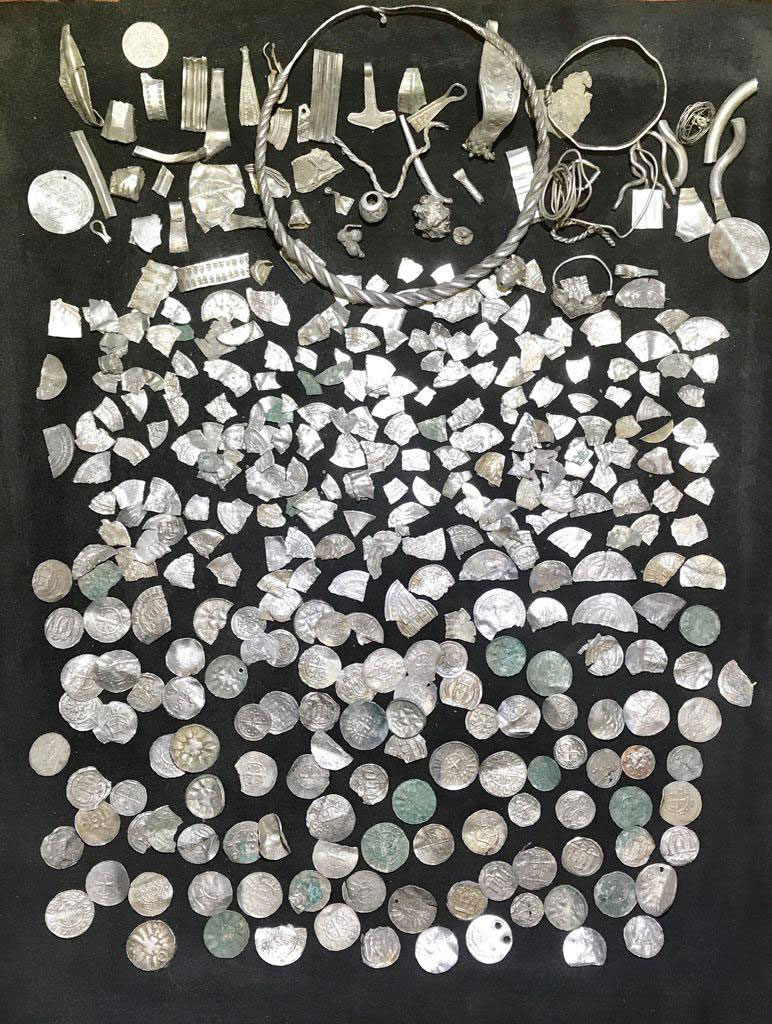A few days ago, a 13-year old girl discovered an extraordinary Viking silver hoard with the largest number of so-called cross coins from the reign of Harold Bluetooth.
Cross Coins were minted by Harold Bluetooth c. AD 975 – 90, probably in Haithabu: It is believed that these coins represented the first initiative to mint a regal and managed coinage in Viking Scandinavia. Although coins had circulated since the 8th centuries in numerous of the Viking market towns, most Vikings would use silver as a weighted treasure when trading, doing commerce or building social networks through gifts.
Most hoards from the Viking Age would, therefore, consist of a mixture of hack silver and tested and split coins; just as is the case with the present hoard. In the late 10th century, however, numerous hoards in present-day Denmark would also contain so-called cross coins, unhacked and unharmed. Why is that?
Background

After AD 963, when Harold Bluetooth converted to Christianity and was baptised, he waged a “cold” war against the large German Empire down south. Part of his effort to keep the Empire at bay consisted in the construction of the magnificent ring fortresses, located inland at strategic places. It is likely they were primarily meant to stock victuals to feed his army. At the same time, he mounted an impressive symbolic manifestation as witnessed by such monuments as Jelling and the bridge at Ravninge. The Danish historian Jens Christian Moesgaard has recently argued in a book that we should understand the Cross Coinage as part of this communicative effort. Thin and not very valuable in terms of their silver-content, they are nevertheless preserved in numerous hoards without having been hacked or split. Likely, they figured as the “King’s money” as payment for soldiers and builders, symbolically sending the message about the new faith of the King and his realm as well as his status as a king with a professionally managed mint. From these payments, the coins seem to have strayed into wider commercial contexts. Accordingly, we know of these coins from single finds in Denmark as well as hoards consisting of hack silver, jewellery and unblemished coins.
The newly found hoard from Rügen belongs to this same category. As can be seen from the initially posted photos, it contains hack silver, jewellery, pecked and tested coins as well as an impressive number of so-called cross coins. Whether all of these are unblemished is not known at present. All-in-all c. 500 – 600 coins have been found, including app. 100 coins belonging to the Cross Coin type. It weighs c. 1.5 kilograms.
Because of the cross coins and their connection with Harold Bluetooth, the media have identified the newly found hoard as the King’s treasure hidden while he was fleeing from the civil war, his son started in the mid-80s. According to later sources, Harold died of his wounds near Jumla, where he was presumably buried.
This interpretation is unlikely. The hoard is not that valuable. More likely, it belonged to a Viking employed in Harold’s army or one of his building projects. Much more, though, will be known when archaeologists and numismatists have had the time to study the hoard in details.
SOURCE:
Silberschatz aus der Wikingerzeit auf Rügen entdeckt
READ MORE:
King Harold’s Cross Coinage: Christian Coins for the Merchants of Haithabu and the King’s Soldiers
By Jens Christian Moesgaard
Publications from the National Museum:
Studies in Archaeology & History Vol. 20:2
University Press of Southern Denmark 2015
Harold Bluetooth’s Cross Coins and a Newly Found Viking Hoard
The post Astonishing Viking Silver Hoard discovered at Rügen in Germany appeared first on Medieval Histories.
Powered by WPeMatico